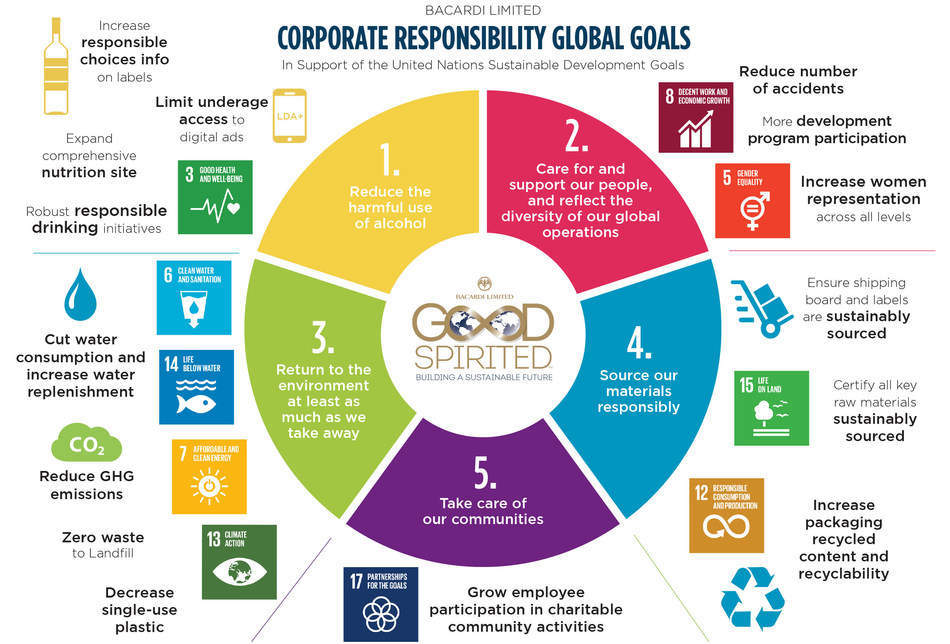Bacardi, the privately held spirits company, has announced the compilation of results of its environmental sustainability goals made in 2014 and expanded its "Good Spirited: Building a Sustainable Future" environmental initiative to now encompass the company's entire Corporate Responsibility (CR) platform.

Image: Bacardi reported that environmental achievements show significant reductions in water usage, greenhouse gas emissions intensity, and waste. Photo: courtesy of PRNewswire / Bacardi Limited.
With the expansion, the Good Spirited platform now comprises Marketplace, which includes responsible marketing and responsible drinking, Philanthropy & Community Investment, People, as well as the initial focus areas of Responsible Sourcing and Environment.
This commitment aligns family-owned Bacardi’s CR platform with most of the United Nations Sustainable Development Goals (SDGs).
Announced in early 2014, Good Spirited was an ambitious environmental sustainability initiative with specific goals in sourcing, packaging, and operations to be achieved by 2017 and 2022 — under the vision to return to the environment at least as much as we take away.
Significant reductions have been achieved in greenhouse gas emission (GHG) intensity (59%) and water usage (50%), as well as Zero Waste to Landfill targets. In addition, the original sourcing goal to obtain 40% of sustainably sourced sugarcane-derived products used to make BACARDĺ® rums were not only achieved but more than doubled.
Bacardi global operations senior vice president Jean-Marc Lambert said: “Every Bacardi employee should take pride in what we have achieved to make the world a better, more sustainable place.
“While we are pleased with our almost 60% reduction in GHG intensity and 50% reduction in water usage, we’re not stopping here—we’re working to achieve a net-zero impact throughout the value chain of our world-class brands. Our goal remains to return to the environment at least as much as we take away.”
Key achievements include:
GHG Emissions: Bacardi cut GHG intensity from manufacturing operations in half more than a year earlier than its 2017 target. At the end of December 2017, the reduction was at 59%, compared to 2006 baseline.
This reduction is equivalent to taking 15,000 cars off the road each year or reducing oil use by 165,000 barrels annually. Hundreds of initiatives implemented globally at Bacardi distilleries, bottling lines, visitor centers, and offices for energy reduction were part of achieving this reduction.
Among the many energy-focused initiatives, Bacardi focused on renewable energy from biogas, heat recovery systems, and wind turbines. Additionally, new biomass boilers installed at the Tequila CAZADORES® facility in Mexico and ABERFELDY® and ROYAL BRACKLA® Scotch whisky distilleries in Scotland reduced the amount of fuel needed for reliable, cleaner energy.
Instead of oil, renewable organic material such as botanicals, wood pellets, wood chips, and agave fibers leftover from production was used as fuel for the biomass boilers. Green electricity — including hydro, solar, and wind — contracts in the United Kingdom, Italy, and Germany were also important tools to reduce the carbon footprint.
Water Usage: The 50% reduction of water use target by the end of December 2017 compared to the 2006 baseline was achieved. A combined effort by more than 25 manufacturing sites was fundamental to reach this milestone.
From water reduction initiatives to water reuse, projects were implemented across operations to ensure better efficiency on the way each drop is used. (Note: a revision was made in 2016 from 55% to 50% to focus on the more environmentally effective “consumptive” water use reduction, which measures water that is not returned to the original water source.)
Waste: A target of achieving Zero Waste to Landfill from manufacturing sites by 2022 was also set in 2014. As of the end of December 2017, 99.8% of the waste generated from Bacardi operations was diverted from landfills (only 0.2% sent to landfill), with one-third of sites already achieving Zero Waste to Landfill status.
Further initiatives focusing on reduction, reuse, and recycling are in place for the remaining sites to achieve this status by 2022.
Packaging: Despite efforts to reduce GHG through glass weight reduction, Bacardi was not able to meet the 10% packaging reduction goal between 2008 and 2017. As of the end of December 2017, the reduction was at 4%.
This missed target was mainly driven by two factors: new packaging design implications and a refocus to overall GHG impact instead of only weight reduction. For example, Bacardi identified contributors to GHG beyond glass weight, including furnace efficiency and transportation logistics.
This learning has been key in developing new goals that focus on supplier collaboration and glass weight reduction, including production efficiency, recycled content, weight, and transportation.
Sourcing: Sugarcane-derived products are the most significant agricultural supply, and Bacardi works with suppliers and industry groups to ensure all suppliers achieve certification to the Bonsucro standard covering human rights and labor conditions, biodiversity, environmental, and economic viability of sugarcane producers.
As of the end of 2017, 86.3% of sugarcane-derived products used to make BACARDÍ rums were sourced from Bonsucro-certified suppliers, well ahead of the original 2017 target of 40%.
Source: Company Press Release
